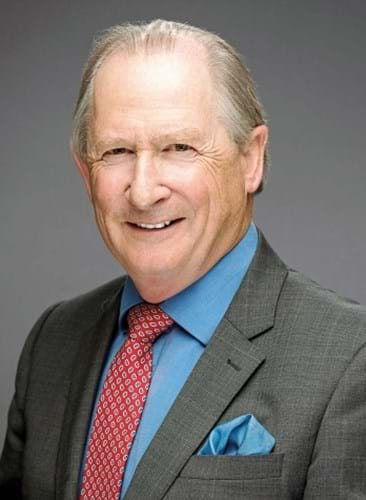
Woolley & Wallis chairman Paul Viney recently stepped down at the Salisbury auction house after nearly 20 years in the role and a quarter-century at the firm.
In his time, the firm has tripled in size by staff and its total annual hammer is now £20m – up from £2m when he joined – which puts it top of UK fine art auction houses based outside London.
His formative experiences included the birth of buyer’s premium, three economic recessions, a stint in New York and the internet’s arrival.
The dawn of Viney’s auctioneering career, in the 1970s, was a time when bosses could express blunt opinions without repercussion and women in boardrooms were few and far between. Today, Woolley & Wallis has several female department heads and a female board director.
Deputy chairman John Axford has now taken over the chairmanship.
Looking back – and to the future
Here, in his own words, Viney reflects on the valuable lessons he’s learned along the way. His experiences provide a recipe for success in regional UK auctioneering.
The regions can attract great specialist talent
Working outside London has its merits, especially if you have children.
We have Michael Jeffery, ex-Christie’s, heading our decorative arts department, and Rupert Slingsby, formerly of Bonhams, who runs the silver department. In my opinion, both are the best in their areas of expertise outside London.
Promote on merit – not to fulfil a gender quota
In previous decades, our business was like others in that we were male-dominated. That needed to change and has done so significantly.
Now we have one female board director out of four, four of our nine heads of department are female – and three of them are auctioneers. They are all there on merit.
Office staff are as important as specialists
Administrative staff may not be income-earning but we couldn’t operate without them. We pay all the staff – from porters to specialists – a bonus in November, assuming we have been profitable, and we have been thus far.
Be ambitious and you can occasionally challenge Sotheby’s and Christie’s
On individual jobs, we do compete with London’s big guns, but Woolleys’ turnover is around £20m-22m, while their revenue is in the billions. When lots sell for more than £1m at auction, the majority of the time it’s at Sotheby’s or Christie’s.
But if you’re talking about lots with six-figure estimates, our track record shows we can achieve prices in that bracket. We’ve now sold 11 lots in the £1m-4m range.
Know what you’re good at
If there was something particularly esoteric, like a Stradivarius violin, I wouldn’t advise selling that in Salisbury because we have no track record. It wouldn’t be in the client’s interest, though it may be in ours. We would strike an agreement with a violin dealer or relevant auction house.
When an important Benin head came to us in 2017, we worked with a London dealer who specialises in that area. It benefited the client, the dealer, the buyer and us to sell it by private treaty – a winning situation all round.
For us, private sales are driven by the vendor
The lines are increasingly being blurred between auctioneering and dealing. I prefer the public forum of auctions – but again, it comes back to the client. If they want a private treaty sale, then we’ll do it.
A big driver is where vendors don’t want their items to come onto a public market and prefer the discretion of a private sale.
Ending generalist sales was a good move…
About 15 years ago now, Woolleys stopped having general sales. Regular dealer buyers said, ‘you’ll regret it and in two years you’ll be back’. For us, it was the best move we made.
Frankly, selling a huge wardrobe for £10 is not cost-effective for us. Many regional auction houses offer the house-clearance package, and that works for them but not for us.
…but an auctioneer can have too many specialisms
When I joined Woolleys, I cut some sales – books, wine, carpets and collectors’ sales – because I thought we didn’t have the necessary expertise. The Asian market, a key specialism for us, has become more selective but the finest things still fetch their money as ever.
The internet has made us a global brand
In our most recent furniture sale, we sold a Pembroke table for £250, bought by a man in Goa! He would not have heard of Woolley & Wallis if it weren’t for the internet.
I don’t see technology making the live auctioneer redundant. It may be wishful thinking, but I don’t.
The advance of technology will only continue – for instance, our marketing department has people who understand Weibo and Snapchat as well as Facebook, and that’s necessary.
But I hope the Kafkaesque nightmare of an auctioneer selling to an empty room will never happen and I don’t believe it will.
Online is really convenient but the great sales have the drama, excitement and theatre and you have to be there to experience that.
Our thresholds have had to rise
If something’s interesting, we might sell it for £100. But our financial and quality thresholds have changed enormously over the years, particularly since we stopped having general sales.
Now, if it’s estimated below £500, we might not handle it.
It’s a sellers’ market, with vendors having a lot more power these days. If you have a lot worth more than £500,000, you wouldn’t expect to pay the auction house any commission. And if you had a picture worth £10m, you could say to the auction house, how much of the buyer’s premium are you going to give me?
Offering guarantees to win business is for the big London houses
We’ve only offered two, possibly three guarantees in my 25 years at Woolleys. Our track record – the fact we have been successful over the past couple of decades – is our calling card.
Buyer’s premium is a fact of life and not going away
I’m old enough to remember its introduction in the mid-70s, which in future years gave auction houses more income to expand. Back then, our catalogues had a few grainy black and white photos. Now Woolleys spends hundreds of thousands of pounds a year on catalogues. In a recent silver sale, our specialists had more than 860 condition reports to do.
The buyer expects more for the premium and rightly so. I can’t think buyers these days want unillustrated catalogues, no phone bidding, no Mandarin speakers at Asian sales – in other words, going back to service levels of 40 years ago. Take all that away and yes, buyer’s premium could come down. But we can’t deliver that level of service without charging for it.
The modern obsession with the bottom line can be misplaced
The client has to come first for us, along with showing integrity and honesty. Profit is not the be-all and end-all. Occasionally if we haven’t made much money out of a job for whatever reason, but we’ve done the right thing for the client, then I’ve been happy.
Similarly, if you have an exceptional sale in one year, you won’t have the finance director breathing down your neck saying ‘you have to do 10% more next year’. Our specialists are motivated because they all earn commission on their own sales – quite unusual in this industry.
Dealers don’t have it easy
I’d have been a terrible dealer. Dealers do a tremendous job. They have it a lot harder than auctioneers in that we don’t take the risks they do. They have to put money up front for objects, which we don’t. If something doesn’t sell at auction, that’s a disappointment but with a dealer, it might be sitting in his or her shop for six months.
I voted for Brexit
I don’t think leaving the EU will affect the auction industry much. If we’re out of Europe, maybe we can get rid of Artist’s Resale Right. It might mean fewer good pictures going to New York, where they don’t have ARR.
A good auction house has a variety of management styles
Take John Axford, the new Woolleys chairman. He’s more driven than me. In setting up Woolley’s Asian department, he’s won a lot of business that you’d expect to head to Sotheby’s or Christie’s, which shows how successful and determined he is.

John Axford is taking over as Woolley & Wallis chairman.
I won’t be a back-seat driver. Hopefully as chairman I’ve been right for the time. But 20 years is a long tenure for a chairman and now it’s time to stand back and let the new generation take over.
As a non-executive director, I’ll continue to bring in business, take auctions when I’m asked and keep the welfare of the company at heart. But I promised John two things: not to criticise and not to interfere. I shall keep those promises.
Paul Viney: from porter to master
- 1971 Aged 23, starts at Phillips as a porter. In those plain-speaking times, Phillips co-owner and later chairman Christopher Weston observed in his letter of employment that the young Viney would “obviously … not be worth this sum [his salary] in the short term”.
- 1973 Made manager of Phillips’ Lisson Grove business, taking his first auction. VAT is imposed on antiques for the first time.
- 1975 Buyer’s premium introduced into the UK by Sotheby’s. “I recall all the dealers dramatically walking out in protest – having already left their bids with the porters, of course.”
- 1976 Viney opens a Phillips saleroom in New York, as vice-president.
- 1979 As US turnover hits $10m, returns to the UK for a Phillips board directorship.
- 1984 Conducts first annual Children in Need auction live on Radio 2 with Terry Wogan, raising more than £5m over 26 years.
- 1986 Made European director at Phillips.
- 1993 First appearance as a valuer on the BBC’s Antiques Roadshow, an engagement that ran until 2013.
- 1995 Joins Woolley & Wallis as managing director.
- 2000 Promoted to chairman at Woolley & Wallis.
- 2009 Becomes chairman of the Society of Fine Art Auctioneers (SOFAA) until 2013.
- 2012 Sells the largest pair of natural pearls ever sold at auction, for £1.4m hammer. “Doesn’t happen every day, but it’s pure theatre when it does,” he recalls.
- 2018 Installed as Master of the Worshipful Company of Arts Scholars.














